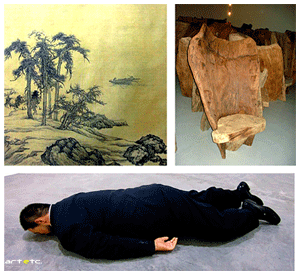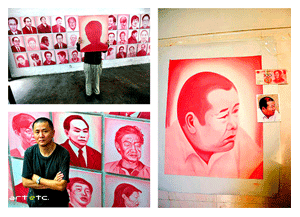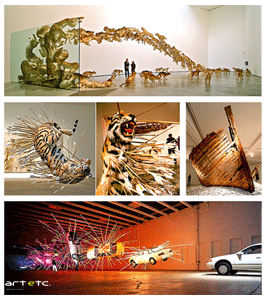- Publisher's Note
- Editorial
- Guerrilla Girls: The Masked Culture Jammers of the Art World
- Creating for Change: Creative Transformations in Willie Bester’s Art
- Radioactivists -The Mass Protest Through the Lens
- Broot Force
- Reza Aramesh: Action X, Denouncing!
- Revisiting Art Against Terrorism
- Outlining the Language of Dissent
- In the Summer of 1947
- Mapping the Conscience...
- 40s and Now: The Legacy of Protest in the Art of Bengal
- Two Poems
- The 'Best' Beast
- May 1968
- Transgressive Art as a Form of Protest
- Protest Art in China
- Provoke and Provoked: Ai Weiwei
- Personalities and Protest Art
- Occupy, Decolonize, Liberate, Unoccupy: Day 187
- Art Cries Out: The Website and Implications of Protest Art Across the World
- Reflections in the Magic Mirror: Andy Warhol and the American Dream
- Helmut Herzfeld: Photomontage Speaking the Language of Protests!
- When Protest Erupts into Imagery
- Ramkinkar Baij: An Indian Modernist from Bengal Revisited
- Searching and Finding Newer Frontiers
- Violence-Double Spread: From Private to the Public to the 'Life Systems'
- The Virasat-e-Khalsa: An Experiential Space
- Emile Gallé and Art Nouveau Glass
- Lekha Poddar: The Lady of the Arts
- CrossOver: Indo-Bangladesh Artists' Residency & Exhibition
- Interpreting Tagore
- Fu Baoshi Retrospective at The Metropolitan Museum of Art
- Random Strokes
- Sense and Sensibility
- Dragons Versus Snow Leopards
- What Happened and What's Forthcoming
- Art Events Kolkata, February – March 2012
- Mumbai Art Sighting
- Art Bengaluru
- Delhi Dias
- Musings from Chennai
- Preview, March, 2012 – April, 2012
- In the News, March 2012
- Cover
ART news & views
Random Strokes
Issue No: 27 Month: 4 Year: 2012
by Rumi Banerjee
Spasm of Life
Can you fathom the ocean, dark and deep?....
 Graduated from Shenyang University in 2008, He Xiangyu was born in Kuandian Dangdon Liaoning Province, China in 1986. He uses crystallized Coca Cola as ink for painting and calligraphy. Various artists have repeated the theme of Coca Cola internationally but unlike those artists who employed the images of Cola products such as its logos or bottles, he focuses his art on Cola’s physical property. He boiled and changed tons of Coca Cola into black crystalline solid and then used it as ink. He introduced the power of Coca Cola in a completely new avatar. His Death of Marat is a rather realistic work; a corpse lying upside down in Tuxedo is a shocking effigy of a Chinese activist Ai Weiwei.
Graduated from Shenyang University in 2008, He Xiangyu was born in Kuandian Dangdon Liaoning Province, China in 1986. He uses crystallized Coca Cola as ink for painting and calligraphy. Various artists have repeated the theme of Coca Cola internationally but unlike those artists who employed the images of Cola products such as its logos or bottles, he focuses his art on Cola’s physical property. He boiled and changed tons of Coca Cola into black crystalline solid and then used it as ink. He introduced the power of Coca Cola in a completely new avatar. His Death of Marat is a rather realistic work; a corpse lying upside down in Tuxedo is a shocking effigy of a Chinese activist Ai Weiwei.
Worth bearing in mind is the derivation of the wooden chairs. The chairs are irregular and primitive shaped and though completely unwavering, they are sllotted together and look shaky. The varied quality of the timber dates back to the building of the canal itself, for which the wood was seemingly selected at random. After years of erosion by wind and water, the now rotten and withered wood imbues the chairs with an atmosphere of bitterness and age, the scars of time lending them a weighty historicity.
It was on these chairs that performers played their seemingly carefree game, the rule of which was to stay aboard the chairs, a fall to the ground signifying death. The performance was titled Man on the Chair. With the story of the performance, spectators almost instantaneously realize that its nub lies in an emphasis of the new “facade” fashioned by the chairs, their predictable utility as stage props exaggerated to the degree that they conquered the intact space.
He Xiangyu presently lives and works in Beijing.
Hall of Shame
“A fool thinks himself to be wise, but a wise man knows himself to be a fool....”-Shakespeare
 Around three thousand officials had been convicted for corruption in a single year in China and when Chinese artist-filmmaker Zhang Bingjian first understood the extent of government corruption in China, he was stunned. “I remember being shocked, a little angry, and then confused, I am not the bureau of corruption, not the police, not a court, I am just a citizen and an artist but I do feel the responsibility to raise my voice, raise questions and record history” -- Zhang. Zhang belongs to a group of Chinese artists whose works often contain biting satire on social events.
Around three thousand officials had been convicted for corruption in a single year in China and when Chinese artist-filmmaker Zhang Bingjian first understood the extent of government corruption in China, he was stunned. “I remember being shocked, a little angry, and then confused, I am not the bureau of corruption, not the police, not a court, I am just a citizen and an artist but I do feel the responsibility to raise my voice, raise questions and record history” -- Zhang. Zhang belongs to a group of Chinese artists whose works often contain biting satire on social events.
Born in Shanghai in 1960, after graduation he focussed on multimedia and installation art. His work has won awards for the National Art Fund.
He stands in front of the portraits for his Hall of Fame project in a studio in Beijing striking just the right cynical tone that allowed him to display an irony through his criticism. He holds a frame for disgraced official Wan Ruizhong whose portrait photography cannot be found on the Internet. His friends said that those are just official figures and there are more than that, and in that moment the seed of the idea was planted and grew into an art installation projecting corruption as- Hall of Fame that features one thousand two hundred portraits of corrupt Chinese officials. He calls it open–ended, sitting amid countless stark, monochromatic portraits of corrupt officials hanging from walls and packed in crates. Some call it Hall of Shame and the colours of all the portraits are pink as they, the viewer can well imagine are blushing. On the contrary pink is the colour of hundred Yuan bill, which is the largest denomination in China. Therefore, it’s the colour of money that seduced these officials and what binds them together.
Whose Arrows Are We Borrowing?
Anger like thousand wolves from his eyes plunged…
 He is now the most well known artist in China. All his projects are based on a wide variety of symbolism and tradition but most of his works draws inspiration from Maoist concepts for content. His brilliant and dramatic Head On installation show at the Deutsche Guggenheim in Berlin in the year 2006 showcased ninety-nine scattered wolves running, galloping, and leaping toward an impenetrable wall. The inexorable speed, aggression and bravery of the wolves are met “head on” by the obstinate wall. As the wolf that leads go down, others follow with force and determination. As those in the front fall and pile up, those behind take up their positions. His works are often political dynamite. There is history and stories in each of his Installation. His installation during 1996 titled Borrowing Your Enemy’s Arrows, an installation of a found fishing boat pierced with three hundred arrows and a Chinese flag that refers to the legend of General Zhu Ge Liang who sent dummy boats to defeat his enemies. His work is not actually taxidermy; in fact, the wolves are made from sheepskins. Taken out of their farmiliar places, these wolves become an overwhelming experience to watch. The Tiger Room is spectacular. There are tigers with arrows pierced into their bodies making their facial expression almost like groaning in eternal pain. Even though they are fake, these tigers are so realistically made that the audience feels pain when they see them.
He is now the most well known artist in China. All his projects are based on a wide variety of symbolism and tradition but most of his works draws inspiration from Maoist concepts for content. His brilliant and dramatic Head On installation show at the Deutsche Guggenheim in Berlin in the year 2006 showcased ninety-nine scattered wolves running, galloping, and leaping toward an impenetrable wall. The inexorable speed, aggression and bravery of the wolves are met “head on” by the obstinate wall. As the wolf that leads go down, others follow with force and determination. As those in the front fall and pile up, those behind take up their positions. His works are often political dynamite. There is history and stories in each of his Installation. His installation during 1996 titled Borrowing Your Enemy’s Arrows, an installation of a found fishing boat pierced with three hundred arrows and a Chinese flag that refers to the legend of General Zhu Ge Liang who sent dummy boats to defeat his enemies. His work is not actually taxidermy; in fact, the wolves are made from sheepskins. Taken out of their farmiliar places, these wolves become an overwhelming experience to watch. The Tiger Room is spectacular. There are tigers with arrows pierced into their bodies making their facial expression almost like groaning in eternal pain. Even though they are fake, these tigers are so realistically made that the audience feels pain when they see them.
Cai Guo-Qiang is a Chinese artist born in Fuji in 1957, who since 1995 has been based in New York. Trained in stage design at the Shanghai Theater Academy, his work has since crossed multiple mediums within art, including drawing, installation, video and performance art.
The Invisible Man
I refuse to describe you…
 His Hiding in the City series was created after the Chinese government devastated Beijing artist village Suo Jia Cun in November 2005. At the time of this destruction, Liu Bolin had been working in Suo Jia Cun. Provoked by his emotional response to the devastation of this site, Liu was determined to use his art as an instrument of wordless protest, calling attention to the lack of protection and negligence the Chinese artists had received from their own government. With his practice of painting his own body into various settings in Beijing, Liu created a space for the Chinese artist, preserving their social rank and stressing their often-troubled relationship with their corporeal surroundings.
His Hiding in the City series was created after the Chinese government devastated Beijing artist village Suo Jia Cun in November 2005. At the time of this destruction, Liu Bolin had been working in Suo Jia Cun. Provoked by his emotional response to the devastation of this site, Liu was determined to use his art as an instrument of wordless protest, calling attention to the lack of protection and negligence the Chinese artists had received from their own government. With his practice of painting his own body into various settings in Beijing, Liu created a space for the Chinese artist, preserving their social rank and stressing their often-troubled relationship with their corporeal surroundings.
Liu Bolin was born in China’s Shandong province in 1973, and he earned his Bachelor of Fine Arts from the Shandong College of Arts in 1995 and his Master of Fine Arts from the Central Academy of Fine Arts in Beijing in 2001. His work has been exhibited in museums around the world. Also known as ‘The Invisible Man’, Liu Bolin's most popular works are from his Hiding in the City series; photographic works that began as performance art in 2005.
Liu has always given special attention to the diverse social problems that go along with China's rapid economic development, making social politics the crux of his pictographic portrayal. By painting his body and camouflaging himself with the city surroundings Liu forces the viewer to acknowledge the messages and, in the process, to reconsider the circumstances of one's own life.